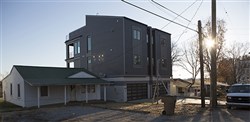 Home > Article
Home > Article
VOL. 43 | NO. 50 | Friday, December 13, 2019
Community plans set tone for neighborhoods
By Kathy Carlson

Many existing houses in Bordeaux have been torn down and replaced with new construction. Rebuilding Together Nashville is working to help Bordeaux residents keep their homes by helping with repairs.
-- Photo By Michele Morrow | The LedgerThe Metro Planning Commission adopted a community plan for Bordeaux-Whites Creek-Haynes Trinity in June 2015.
It was amended in August 2017 and later revamped to include a small-area community plan that’s specific to Haynes Trinity. Meetings with community members to develop the Haynes Trinity plan took place in late 2017.
Community plans – 14 in all for Nashville – are developed as part of the Nashville Next long-range plan for growth, development and preservation through 2040. The Metro Planning Department writes the plans in collaboration with community residents, businesses and others to serve as “the key planning policy guide” for “future built and natural environments.”
The Bordeaux-Whites Creek-Haynes Trinity area encompasses Greater Bordeaux and much of northwestern Davidson County, a 70-square-mile area that represents about 13% of the land area in Metro. About half of the land area is used for residential purposes, the plan says.
Bordeaux is mostly suburban, while Whites Creek is mostly rural. Most of Bordeaux-Whites Creek-Haynes Trinity is zoned for single and two-family dwellings with clusters of commercial zoning along Trinity Lane and the I-65 Interchange.
Bordeaux is considered T-3 Suburban under a 7-point system that Metro’s planners use for classifying development patterns. The scale goes from T-1 Natural for parks and open land, to T-6 Downtown, with another classification for areas with special uses, such as industrial areas.
The community plan embraces housing diversity that’s tailored to the character of the area and the lifecycle needs of people living there.
“Housing diversity allows for aging in place – the idea that there is housing in a neighborhood or community for people at each point in their life,” from first home to family home to smaller home in retirement to assisted living.
“By 2040,” the plan states, “seniors will make up one-quarter of the Nashville/Davidson County population, fewer than one in five households will have children and the fastest-growing type of household will be the single-person household.”